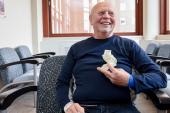Aortic Valve Replacement: What’s on the Wish List for Future Devices?
Innovators are probing new materials and delivery systems, but the hunt for ways to curb or reverse calcification is wide open.

For all the innovation, engineering, and miniaturization that has helped to refine surgical and transcatheter aortic valve replacement over the last few decades, they still fall short of ideal. That reality was brought home to Benoy Shah, MBBS, MD (Wessex Cardiac Centre, University Hospital Southampton, England), when he was confronted with a retired mechanical engineer, age 71, who was offered a state-of-the-art tissue valve but balked after reading the consent form.
“In my experience, engineers always choose mechanical valves,” Shah said. “He was absolutely astonished that people would choose a valve where potentially it might not last, and they'd have to go through it all over again. . . . He said, ‘If you're going to put me through this, I just want to do it once.’”
A once-in-a-lifetime procedure that’s safe and effective; entails a quick learning curve for operators; requires minimal recovery time; and doesn’t pose problems for other interventions down the road, serve as a nidus for future complications, or require lifelong anticoagulation—these are among the drivers of innovation in the aortic valve space.
“There will probably never be an ‘ideal’ aortic valve, but there certainly are developments that have happened over the past 10 years, and will progressively continue to happen over the next 10 years, that will hopefully address some of the current limitations,” said Martin Leon, MD (NewYork-Presbyterian/Columbia University Irving Medical Center, NY), a long-time pioneer in the field of transcatheter heart valves. “Ideal” might not be a fully attainable goal, “but I think we're moving closer to a ‘more perfect’ aortic valve.”
Ideal Valve Ingredients
Asked to describe the components of an ideal replacement aortic valve, physicians who spoke with TCTMD had different items on their wish lists.
Leon noted that, for TAVI, innovation has focused on the delivery system, the frame, and the leaflets themselves, and said he believes efforts should continue to do so. Delivery-system profiles have come down by almost 50% over the past decade, he noted, vastly reducing rates of vascular complications and making it possible for the majority of procedures to happen via the transfemoral approach. More recently, the ability to steer and torque these systems has improved the ability to optimize valve alignment with the native anatomy.
I think we're moving closer to a ‘more perfect’ aortic valve. Martin Leon
“There's something to be said for having a more natural location of the valve, because that may improve valve performance and may improve access to the coronaries—it’s not so easy to prove these things in clinical trials, but I certainly think most people would agree that having proper commissural alignment, which is the way the surgeons implant valves, is something that we would recommend,” Leon said.
Frame sizing also has room for improvement, since most commercialized TAVI devices only come in three or four different sizes. “The reality is, most of the time, the size you need is not exactly one of those choices,” Leon said. Then there’s the problem of accommodating subsequent devices. Frame technologies, both surgical and transcatheter, are now being designed for future valve-in-valve procedures by having frames that can be expanded further, at a later date, or from its initial dimensions, without needing to fracture the valve.
Lastly, said Leon, are the leaflets themselves. A durable leaflet “is the holy grail” of prosthetic valve innovation. “A surgical valve lasts 10 or 15 years,” he said. “If you're going to be treating people in their sixties or bicuspid patients even earlier, then you're going to expect that valve is going to wear out, and it may wear out not only once, but twice. And in some patients there may be accelerated structural valve deterioration. So durability is a big issue.”
For Dean Kereiakes, MD (The Christ Hospital Heart and Vascular Center, Cincinnati, OH), what constitutes an Achilles’ heel for aortic valve interventions today is different than 15 years ago. “The major remaining challenges or obstacles to further expansion of catheter-based aortic valve replacement at this point are not pacemaker and stroke. Those were things that we dealt with early on,” he told TCTMD. “The two big challenges now are valve durability and coronary access.”
The ideal valve, he suggested, would be one “that has the biggest effective orifice area [EOA], at any specified valve size, one that will last for 30 or 40 years—which is distinctly uncommon unless you're talking mechanical valves at this point in time—and one that would also not require lifetime oral anticoagulation. These are the boxes to check.”
If you have checked those boxes—maximal EOA, durability, no need for oral anticoagulation, and something that can accommodate transcatheter-based replacement—then you've got a winner. Dean Kereiakes
Echoing a point also made by Leon, Kereiakes said that any device, be it surgical or transcatheter, should be able to accommodate a future transcatheter valve if a redo procedure is warranted down the road, something current mechanical valves are not designed to do.
Durability was top of the list, too, for European Association for Cardio-Thoracic Surgery (EACTS) President Friedhelm Beyersdorf, MD, PhD (University Hospital of Freiburg, Germany), who pointed out that some surgical valves have proven durable beyond 20 years, while TAVI valves have just 5 years of data.
“Second,” he said, an ideal valve “should have no need for anticoagulation—that would be perfect. Third, this valve should be available at all times, in all sizes. And fourth, the implantation of this valve should be done without any side effects or complications.”
Today, mechanical valves make the grade for no anticoagulation and availability in all sizes at all times, Beyersdorf noted. As such, an active area of investigation is geared towards the development of thrombi-resistant materials as well as novel leaflet geometry that can reduce the risk of thrombus formation without inhibiting flow. These include bicuspid and tricuspid prostheses that mimic the native valve, but also four-leaflet and mono-leaflet designs.
Beyersdorf’s fourth condition, however—that the device be implantable without side effects or complications—represents a different take than that of his cardiology colleagues. Streamlining deliverability has been the focus of transcatheter approaches, and Beyersdorf acknowledged that, for patients, the least-invasive approach is attractive.
“Of course, you and me and everybody would like to have the least-invasive procedure, there is no question about it. But on the other hand, we not only would like to have the least-invasive procedure, but we also would like to have a procedure which hopefully cures my health problem completely. I do not want to have a procedure over and over and over again,” he said, likening such a scenario to ablation for rhythm disturbances or to PCI and CABG for progressive coronary artery disease. “In the ideal world,” Beyersdorf said, suggesting that he, too, has treated his share of patients like Shah’s engineer, “you'd have one treatment and it’s over and you can forget the whole thing.”
New Tech for Old Problems
Kereiakes was the principal investigator for a pilot study published recently in JACC: Cardiovascular Interventions using the investigational Tria aortic valve (Foldax), a device that he believes has the potential to solve many of the problems plaguing the field today. Intended for either surgical or transcatheter delivery, the valve’s hallmark features include a durable biopolymer that does not use animal tissue and does not require lifelong anticoagulation, as well as a streamlined profile that maximizes effective orifice area (EOA) and allows for optimal hemodynamics.
“If you have checked those boxes—maximal EOA, durability, no need for oral anticoagulation, and something that can accommodate transcatheter-based replacement—then you've got a winner, and this potentially hits all categories,” said Kereiakes.
Leon agreed that if a valve implant has excellent hemodynamics, no signs of thrombus, and lasts for decades, then “everybody's going to say that that's pretty much as good as we can get.”
But there are other areas of active investigation, most notably in tissue engineering. These innovations typically involve scaffolds and bioresorbable polymers that disappear over time, allowing the body’s own cells to infiltrate and endothelialize the devices. Leon and Kereiakes gave the example of Xeltis, a company developing platforms for endogenous tissue restoration (ETR), wherein tissue regrowth is promoted to form new, fully functional valves.
I think starting with a design that emulates a structure that we know can last a hundred years is a pretty good starting point. Benoy Shah
Beyersdorf, while also enthusiastic about the prospect of tissue engineering, pointed out that these valves would not fulfill one of his requirements, namely, availability in all sizes at all times. “I'm sure that one day we will have a very good valve made out of our own cells,” but there are challenges ahead, he said. “At least currently, in animal experiments, it takes a while before these valves are fully grown and even then, the durability of these valves is not known yet.”
Indeed, proving that these devices and strategies will be any more effective or durable than the technologies in use today offers its own set of hurdles, Leon noted, pointing to the shortcomings of bench testing or animal models as substitutes for a human heart. An area of burgeoning interest is in imaging modalities like 18F-sodium fluoride (18F-NaF) PET/CT scanning to identify microscopic signs of calcification and degeneration long before they’re clinically meaningful.
“We're going to be developing some very interesting imaging modalities,” said Leon, “that might give us not direct measures of durability but [rather] surrogate measures that could be meaningful, allowing us not to have to wait 10 or 15 years to say that valve A is going to be more durable than valve B.”
Beating the Best
Shah, too, cited polymeric valves like the Tria as “in theory, a disruptor,” by offering the durability of a mechanical valve without the need for lifelong warfarin. Yet he also offered a note of caution, citing the sheer complexity of the native aortic valve and its function.
In the majority of people, their own valves “will work for a very long time, sometimes a hundred years or more if the person lives that long, without developing any major issues,” Shah said. That likely explains why, despite decades of development, the artificial valves that come closest to “ideal” are the ones that most closely mimic the native valve, he added.
“We have known for some time that the shape of those cusps and the effect in terms of physics that it causes when the valves open and close—and the tiny, little eddy currents of flow which are generated in your aortic root, that then also encourage flow down your coronaries in diastole and other such things—there's a benefit to that beyond which I think a lot of us think about the valve on a sort of simple day-to-day level,” Shah said. “Unless someone that studies physics comes up with a different model that clearly can last longer than the current valves can, I think starting with a design that emulates a structure that we know can last a hundred years is a pretty good starting point.”
In fact, everyone that spoke with TCTMD acknowledged that the ideal aortic valve, in most cases, is the one we’re born with. “The best would be your own valve if it could stay [healthy], even after 100 years, still working, everything perfect: this will be the ideal,” Beyersdorf said.
However, how to stop aortic valve disease and dysfunction from getting a toehold, or reversing it once it starts, has lagged behind device innovation.
“You can think of aortic stenosis as kind of like atherosclerosis of the valve,” Shah said. “What's happening to the leaflets is quite similar to what happens to your endothelium in the coronary arteries.”
That means the pathobiology for both diseases is also “quite similar,” he continued.
We are light years away from any true results which could really help us in preserving our own valve forever. Friedhelm Beyersdorf
“Cigarette smoking and badly controlled blood pressure and badly controlled diabetes and very high lipids, et cetera—all of these things can basically lead to a firing up of your valve in the same way you can get a firing up of your arteries,” he said. There are also poorly understood genetic components to how calcium is metabolized or “laid down in the valve” that affects some people more than others.
But understanding the common pathways for both aortic and coronary artery disease have not, to date, led to the same strides in terms of pharmaceutical options for primary and secondary prevention, Leon noted.
“There are very few randomized clinical trials looking at how we can prevent the progression of calcific aortic valve disease,” he said. “About 10 years ago, there were a series of studies using statins [and] three major randomized trials, and none of them worked.”
Statins, though, were “a fairly blunt instrument,” Leon continued. Newer research using PCSK9 inhibitors and other antisense technologies to Lp(a), “which may be one of the foundational causative elements in aortic stenosis,” are “provocative” and promising, Leon said. “I expect that there's going to be a rebound pharmacotherapy period where we start looking at more exotic and interesting approaches to prevent the progression of aortic valve disease.”
Kereiakes, too, called the renewed interest in lipid-lowering medications, and especially those targeting Lp(a), an area of “real interest.” He highlighted the increasing body of evidence implicating Lp(a) in endothelial dysfunction, formation of foam cells, and promotion of a pro-inflammatory state, which in the setting of the aortic valve promotes valve thickening and mineralization.
Given that potential, the dearth of studies actively looking at aortic calcification as drug target is striking.
A recent review lists just two clinical trials testing lipid-lowering agents for Lp(a)-mediated aortic valve disease: EAVaLL, a phase I trial comparing the effects of niacin versus placebo on calcium progression, as measured by CT, and EPISODE, a small phase III trial comparing a PCSK9 inhibitor plus statin against a statin alone for a primary endpoint of average annual change in aortic-jet velocity. Ionis Pharmaceuticals has previously said it would be testing its investigational antisense medicine targeting apolipoprotein(a) in aortic valve stenosis, setting out the rationale in a pair of dose-ranging studies in the Lancet. But there’s no signs that the trial is underway.
In 2019, the agent, now known as pelacarsen, was licensed from Ionis by Novartis for exclusive worldwide development and commercialization. A Novartis spokesperson confirmed to TCTMD that its pivotal, multicenter, double-blind, placebo-controlled, phase III Lp(a)HORIZON trial, now underway, aims to demonstrate of cardiovascular risk in patients with established CVD and elevated Lp(a), but according to ClinicalTrials.gov, aortic stenosis is not part of the primary or secondary endpoints. “Novartis does not have any clinical trials with pelacarsen in any additional indications,” the spokesperson said.
Future Frontiers
With or without pharmaceuticals, preventing aortic valve disease may be the biggest, untapped frontier—ripe for lifestyle interventions.
“I think we can certainly try and make people take better care of their own general health,” Shah said. “If you think about the number of people that reach old age and die without ever having needed to have anything done to their aortic valve, it's obviously most human beings. It's clearly more than 50% that they don't need an aortic valve replacement at some stage in their life.”
Genetics will still play a role, though. “Definitely efforts that can be taken to improve [cardiovascular risk factors] will improve all sorts of general health conditions and will also, I have no doubt, help reduce or aortic stenosis, but you're never going to eliminate it completely,” said Shah. “So if people are going to need to undergo some sort of valve replacement, that's where the work comes in as to: what is the ideal valve replacement?”
Much has been accomplished in the last decade, said Leon, with over a million patients treated with transcatheter valves alone. “I think there's a lot that people should feel good about, but I don't think the story has quite ended yet,” he predicted.
Indeed, said Beyersdorf, “we are light-years away from any true results which could really help us in preserving our own valve forever, but nevertheless, this would be definitely number one of my choices.”
Shelley Wood was the Editor-in-Chief of TCTMD and the Editorial Director at the Cardiovascular Research Foundation (CRF) from October 2015…
Read Full BioDisclosures
- Beyersdorf reports receiving royalties from Köhler-Chemie and being a co-founder and shareholder with Resuscitec.
- Leon reports research support from Abbott, Boston Scientific, Edwards Lifesciences, and Medtronic; serving on advisory boards (unpaid) for Abbott, Boston Scientific, Edwards Lifesciences, Medtronic, and Gore; and holding equity in Alta, Ancora, Conveyor, East End Medical, K2, Medinol, PI-Cardia, Triventures, Venus, MedTech, Valve Medical, and XenterMD.
- Kereiakes reports consulting fees/honoraria or other payments from Svelte Medical Systems, Sino Medical Sciences Technology, Shockwave, Elixir Medical, Caliber Therapeutics/Orchestra Biomed, CeleCor, HLT, Foldax, and Ablative Solutions.
- Shah reports serving as president of the British Heart Valve Society.





Comments